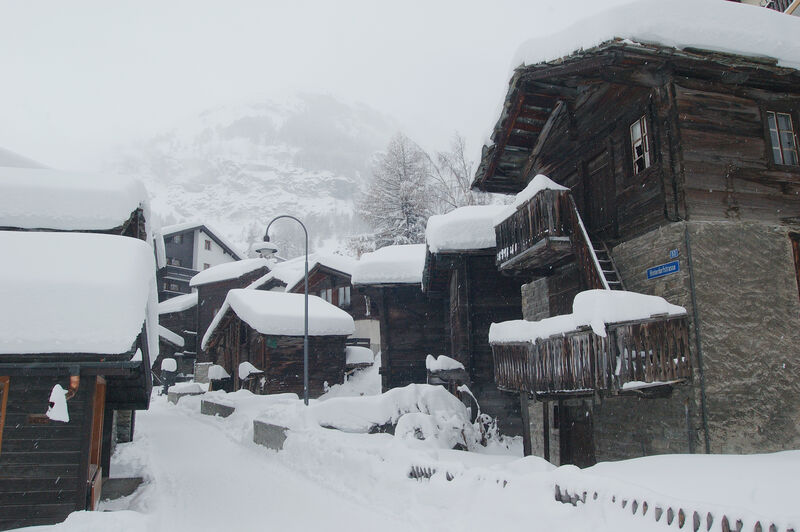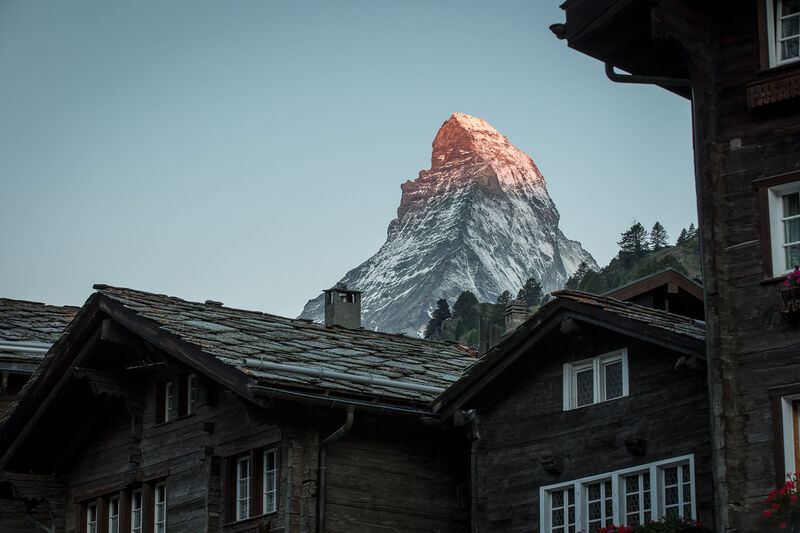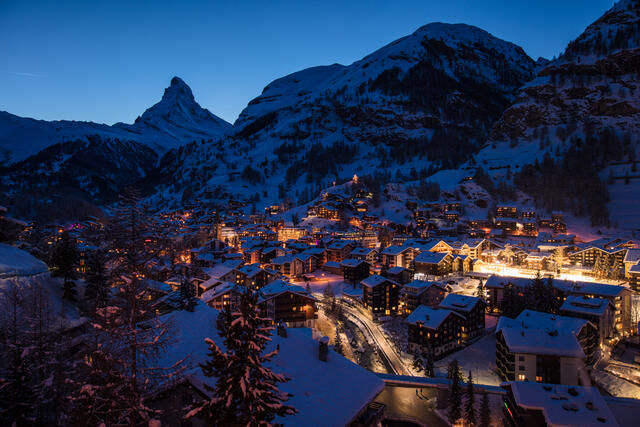Nestled in the Swiss Alps, the village of Zermatt is a breathtakingly beautiful place whose main attraction is undoubtedly the impressive Matterhorn. The traditional architectural style with lots of wood and the car-free streets make it a picture-book mountain village, just like the cliché image of Switzerland.
Zermatt is one of the most famous ski resorts in winter and has many mountain attractions in summer thanks to its excellent infrastructure, making it one of the most popular travel destinations in the Alps. Even though the village is very touristy, it has retained a certain authenticity and is a place we like to visit again and again.
In this article, you’ll find out everything you need to know about the village of Zermatt and how to get there.
About the village of Zermatt
The idyllic mountain village of Zermatt lies in the Alps at an altitude of 1620 meters. The village is surrounded by no fewer than 38 four-thousand-meter peaks. In the rest of Europe, there are a total of 76 mountains over 4000 meters high. This means that half of these impressive giants are located in the municipality of Zermatt.

A paradise for mountaineers, who visited the mountain village in droves, especially in the 19th century, to celebrate numerous first ascents.
This fact and, of course, the unique Matterhorn were the main reasons why Zermatt developed from its humble rural beginnings into one of the most famous and fashionable tourist destinations.
Thanks to Zermatt’s location, the village enjoys a unique microclimate, which is rather dry and mild despite the altitude, making it a popular climatic and high-altitude health resort quite early on.
While the village has little precipitation, the high mountains all around are real snow catchers and record above-average amounts of precipitation. It is therefore not surprising that Zermatt has long been a paradise for skiers and is one of the few places in Europe that also has slopes open in summer.
Getting around in Zermatt
Zermatt has always been a car-free village, which makes it a very special place and contributes to the unique mountain romance.

Private vehicles are only allowed to drive as far as Täsch, 5 kilometers away. The road from Täsch to Zermatt is not open to regular traffic.
There are several parking facilities available to visitors in Täsch. There are 2,100 covered parking spaces at the Matterhorn Terminal and over 1,000 open and covered parking spaces provided by private individuals.

At the Matterhorn Terminal in Täsch, you can board one of the modern shuttle trains and travel directly to the center of Zermatt. The shuttle train runs every 20 minutes and the journey only takes 14 minutes.
The terminal also offers a service center with a ticket counter, ATMs, stores and much more.
Another option is to use one of the various private cab services that operate between Täsch and Zermatt.
You might also like the following article:
Zermatt eBus
In Zermatt, where cars are not allowed, walking is the main mode of transportation. On foot you can really relax and make the most of your vacation, free from any hustle and bustle and stress. Thanks to the absence of cars, you can even treat yourself to an extra glass of wine at dinner without worrying.

Nevertheless, especially if you have a lot of luggage or your accommodation is far away from the station, it is practical that there are electric vehicles that are allowed to run in the town.
Private eTaxi providers pick you up at the desired point and drive to the other end of the village within a few minutes.

There are also two eBus lines (green line Bergbahnen & red line Winkelmatten) which run regularly. You can find the timetable here.
Tip: Click on the markers at the bottom of the map to see the name of the bus stop or zoom in to get a detailed view.
Although these electric cabs and buses provide a form of transportation, they do not overcrowd the village. The narrow streets of Zermatt are still dominated by pedestrians. They are also emission-free vehicles and have no loud engine noise, which contributes to the tranquillity of the village.
Made in Zermatt
Because there are very few places that are completely car-free and the narrow, bumpy and sometimes snow-covered roads in Zermatt require a very unique type of vehicle, the eBuses are all “Made in Zermatt”
There are two manufacturers who all produce these electric vehicles with the specified dimensions (1.40m wide, 4m long, 2m high) in Zermatt.
The battery is the heart of these vehicles and is charged with electricity from the local power grid. Depending on factors such as the age of the battery, the weight of the charge, the time of year and the terrain, it has to be charged every day or every other day.

With a weight of 2000 kilograms, these buses can drive effortlessly through the snow-covered terrain of Zermatt in winter. Their service life is between 30 and 40 years.
A total of around 500 e-buses are registered in Zermatt. Some of them have been in operation since 1977 thanks to their robust construction and sophisticated technology.
Activities in Zermatt
With the unique mountain scenery around Zermatt, there are countless things to do, which we have written a separate article about. Here are just a few of the highlights:
- Excursion to the Gornergrat
- Small Matterhorn with ice grotto
- Exploring the hiking paradise of Zermatt
A walk through the village
Of course, the mountain world around Zermatt is the tourist magnet for Zermatt, but we loved simply strolling through the village on each of our visits. Exploring the narrow streets and admiring the traditional houses built with lots of wood and stone. And of course, there are always interesting views of THE summit.

The Matterhorn, which is officially (according to a Google study) the most photographed mountain in the world. Of course, we can’t resist taking countless pictures of this perfect Toblerone summit as seen from Zermatt.
Of course, the place has changed massively from its beginnings as a modest mountain village to a tourist hotspot. If you want to experience seclusion and the “original” Switzerland, you would probably be better off somewhere else.

Nevertheless, we think the village has retained a certain authenticity and you can still sense something of the fairytale ambience of a mountain village as you stroll through the alleyways.
Apart from the unbeatable views, Zermatt also has a variety of stores and restaurants to suit all tastes. There are also over 100 hotels, from old to modern. Three notable establishments with bars that are also open to non-hotel guests include:
- Monte Rose
- The Grand Hotel Zermatterhof
- Mont Cervin Palace

The lively main street is lined with luxury boutiques, sports stores and quirky bars. In the side streets you will find centuries-old wooden sheds and chalets that exude a little flair of the original village.
Old part of the village of Zermatt
The old part of Zermatt is located on Hinterdorfstrasse right in the center of the village. This old part of Zermatt is a veritable treasure trove of historic buildings.
More than 30 buildings have the classic architectural style of the original Walser settlers, including barns and granaries that are up to 500 years old. They represent a piece of history and show how the farmers used to live.
The traditionally designed buildings in the old village are a real feast for the eyes for photo enthusiasts. Many of them stand on flat stone slabs balanced on stilts to keep mice out.

All of these houses, which were built here between the 16th and 18th centuries, are made of robust larch wood. This material is resistant to pests and is available in abundance in the region. The ageing process causes the wood to darken due to sunlight and weathering. This improves the structure’s ability to absorb and store heat as it ages.
A walk through the narrow streets of the old part of the village feels like a journey back in time. Visitors can take part in guided tours of the village in various languages.
The most beautiful photo spots in the village

1. Old part of the village

2. Church square and Community Center terrace

3. Church bridge

4. Rideweg viewpoint

5. Zen stecken

Final thoughts
Visiting the village of Zermatt will undoubtedly be an unforgettable experience. We recommend that it is on everyone’s bucket list. The picturesque village offers a wide range of activities and attractions, all surrounded by breathtaking views of the mountains.
The charming atmosphere, warm hospitality and natural beauty make Zermatt a must-see for anyone traveling to Switzerland.
